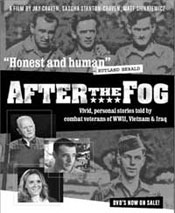 Documantary shows veterans still hurt long after their wounds have healed
Documantary shows veterans still hurt long after their wounds have healed
by Sally Pollack
Veterans of wars from Iraq to World War II form the cast of characters in a documentary by Vermont filmmaker Jay Craven.
The movie, “After the Fog,” consists of interviews with 11 U.S. veterans, more than half of whom are Vermonters. In the film, the vets relate their reasons for going to war, their combat experiences and their thoughts about combat.
Craven, who writes a monthly column for The Burlington Free Press, co-produced and directed the movie. He will be at screenings this weekend in Burlington (see box).
One of the World War II veterans featured in the film, Bob Miller of Brattleboro, approached Craven about making a war-related movie.
Miller was interested in a documentary about WWII vets, with a focus on the Veterans Administration Hospital in White River Junction. He has been a patient there seven years; Miller said he envisioned the movie as “an homage” to the hospital.
As the co-producers began discussing and researching the movie, including conducting interviews with providers at the hospital, the original idea was refined. The film, under the direction of Craven, took shape as a series of interviews with veterans…
Miller, 81, the co-producer, recalled Craven’s thinking when the director suggested re-tooling the movie’s focus.
Craven was concerned that a movie centered on the VA hospital would be “like an infomercial,” Miller recalled. And “duller than dishwater,” according to Miller.
But a focus on the veterans, Craven believed, would make a compelling film. “I must say that Jay was right,” Miller said.
The idea is that the veterans — 10 men and one woman — would develop as characters through the course of the film. Except for the closing credits, when each person is identified by photograph, name and war, no context or explanation is given about who they are or when and where they fought.
In this way, Craven hoped to establish an intimate perspective from and connection with each veteran, he said.
“The audience finds the information about them in their voices, in their subtexts, in their facial expressions, in the emotions that are expressed or not expressed,” Craven said. “It’s the same with actors: You come to know them through what they themselves put out, and not by what we say about them.”
The movie cost about $80,000 to make, Miller said. It is “his first and last” producing effort.
“I’ve seen the film four times, and even though I’m in it, and I see it again and again, I’m absolutely moved,” Miller said. “It really does what we set out to do: Which is say something that would appeal to the broadest possible public about war and its costs and aftermaths in terms of human beings.”
(In accordance with Title 17 U.S.C. Section 107, this material is distributed without profit to those who have expressed a prior interest in receiving the included information for research and educational purposes. VT has no affiliation whatsoever with the originator of this article nor is VT endorsed or sponsored by the originator.)
ATTENTION READERS
We See The World From All Sides and Want YOU To Be Fully InformedIn fact, intentional disinformation is a disgraceful scourge in media today. So to assuage any possible errant incorrect information posted herein, we strongly encourage you to seek corroboration from other non-VT sources before forming an educated opinion.
About VT - Policies & Disclosures - Comment Policy



